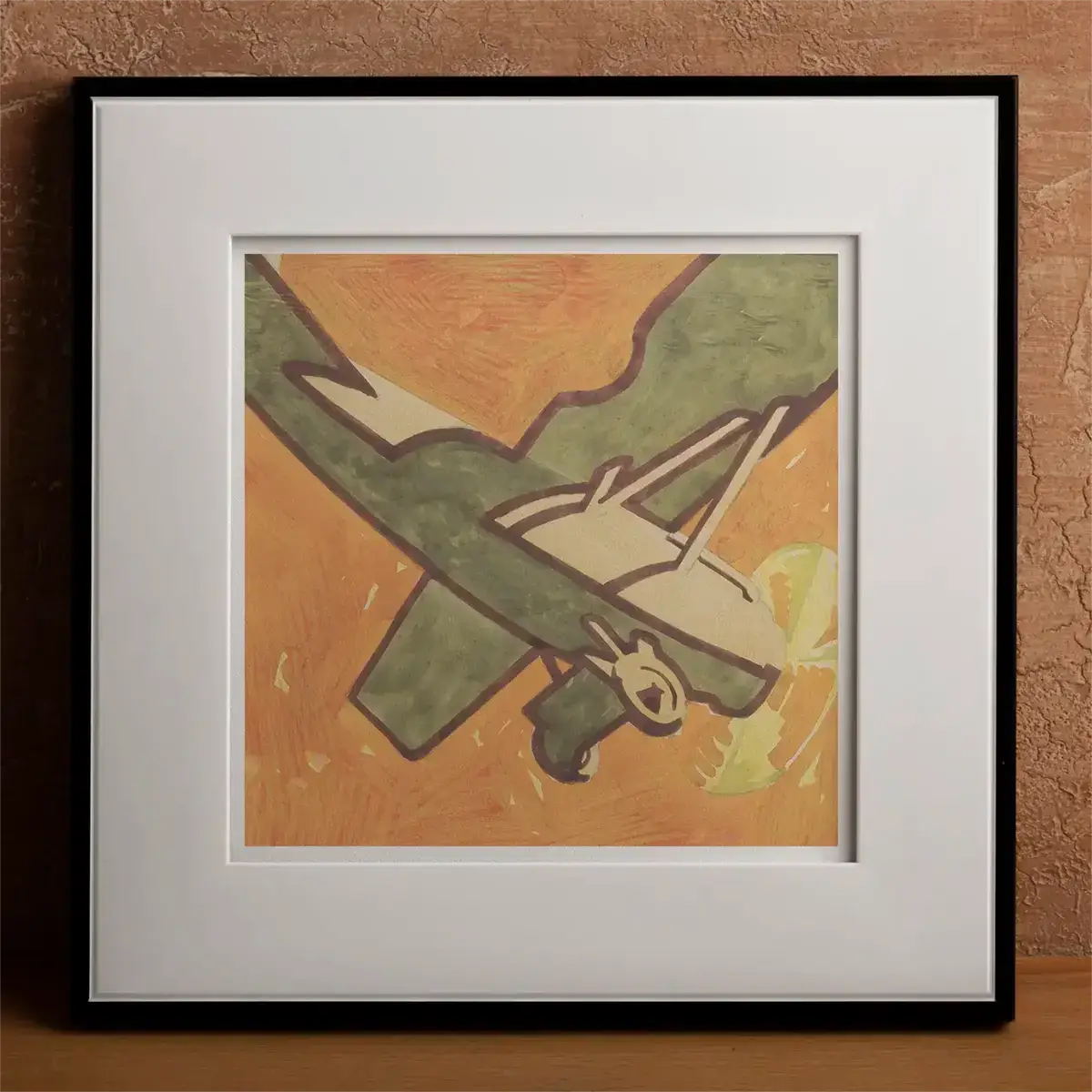Under a dawn that broke over the emerald slopes of Ngunut, Java, Reijer Johan Antonie Stolk was born into a world where the tropical pulse met colonial ambition. The early light of March 30, 1896, cast vivid shadows across a land steeped in tradition, even as European influence subtly interwove its narrative. In that moment, the converging destinies of a Javanese mother and a Dutch father were inscribed in the fabric of history—an inheritance that would later sculpt every line, print, and color of his artistry.
This is a story of migration and metamorphosis, where the lush vibrancy of Java gives way to the disciplined chiaroscuro of the Netherlands. About the odyssey of an artist who navigated continents and media with equal parts rigor and passion. A journey that continues to resonate in the silent halls of museums and the vivid memories of art history. It's a tale told not in the mere recounting of dates and events but in the interplay of light and shadow, of bold brushstrokes and delicate engravings that capture the human form in both art and anatomy.
Key Takeaways
- An Intriguing Heritage: Born to a Javanese mother and Dutch father on March 30, 1896, Reijer Stolk forged a life that seamlessly fused Indonesian tradition with the evolving currents of European modernism.
- Shifting Horizons: A childhood move from Java’s lush tropics to the Netherlands’ industrious lowlands transformed Stolk’s worldview, granting him an acute sense of cultural contrast that later shaped his art.
- Passionate Polymath: Stolk excelled in painting, sculpture, graphic design, Batik, and even patented inventions—straddling boundaries with fearless curiosity.
- Global Ties: A commission to travel to the Gold Coast and Nigeria in 1930 revealed Stolk’s voracious appetite for cross-cultural encounters, influencing both his textile patterns and the evolution of his palette.
- Anatomical Reveries: Whether carving into wood for delicate prints or studying the intricacies of back muscles, Stolk’s fascination with the human body elevated scientific illustration into arresting art, his woodcuts eventually compiled in a posthumous 1946 volume.
Origins and Early Migration

Reijer Johan Antonie Stolk's life began on March 30, 1896, in the verdant landscapes of Ngunut, a region nestled within the island of Java, then a jewel in the crown of the Dutch East Indies. Born to a Javanese mother and a Dutch father, his very origins were a confluence of two distinct worlds—a duality that would subtly yet powerfully shape his artistic trajectory. The late 19th century Dutch East Indies presented a complex tapestry of colonial power, where Dutch authority held sway over a diverse indigenous population.
Sometime between his third and twelfth year, Stolk's family embarked on a significant journey, leaving the tropical warmth of East Java for the lowlands of the Netherlands. This migration, a moment both abrupt and transformative, shifted the backdrop of his formative years from the vibrant traditions of Indonesia to the reserved and industrial rhythms of Western Europe. By 1910, at approximately fourteen years of age, Stolk’s path led him to the Applied Arts School in Haarlem—a decision that would cement his future in the arts.
Chronology of Reijer Stolk's Life and Career
| Year | Event |
|---|---|
| 1896 | Born in Ngunut, Java, Dutch East Indies |
| 1899–1908 | Migrated to the Netherlands with family |
| 1910 | Enrolled in the Applied Arts School in Haarlem |
| 1922–1926 | Lived in Vienna, registered aircraft patents |
| 1930 | Traveled to the Gold Coast and Nigeria for textile design inspiration |
| 1946 | "Anatomische studies in houtsneden" published posthumously |
| 1945 | Died in Amsterdam |
Haarlem: The Crucible of a Young Artist

In 1910, the Applied Arts School in Haarlem became the stage where Stolk’s nascent talent would be honed. Haarlem, celebrated as the cradle of the renowned Haarlem School of painting during the Dutch Golden Age, provided a setting where artistic legacies met innovative ambition.
Under the guidance of distinguished mentors, Stolk was introduced to a spectrum of artistic philosophies:
- Chris Lebeau, a painter and graphic artist, presented the burgeoning aesthetics of Art Nouveau, emphasizing organic forms and decorative unity.
- Eduard August von Saher, a sculptor who directed both the Museum of Arts and Crafts and the School of Arts and Crafts in Haarlem, instilled an appreciation for three-dimensional form and rigorous craftsmanship.
- Samuel Jessurun de Mesquita, renowned for his stylized wood engravings and pivotal role in the Dutch arts-and-crafts movement, shaped Stolk’s graphic sensibility with emphases on bold lines and stark contrasts. Notably, Maurits Cornelis Escher was also among de Mesquita’s pupils, underscoring the rich, shared lineage of artistic excellence.
At Haarlem, the principles of Nieuwe Kunst—the Dutch iteration of Art Nouveau—were interwoven with indigenous patterns from the Dutch East Indies. This environment nurtured Stolk’s ability to meld his dual heritage with the traditions of Western art, establishing a foundation that would inform every subsequent creative pursuit.
A Polymath’s Palette: Mastery Across Media

Stolk’s work resists confinement to any single medium. As a graphic artist, his style was consistently described as fresh and contemporary, because at the time... it sure was. Marked by intricate lines that conveyed both precision and dynamism. Graphic works lauded for their exactitude and inventiveness—a testament to technical prowess and innovative vision.
In painting, his canvases such as "Flowers" and "Mountain Landscape" exhibit a bold use of color and a dedication to capturing natural splendor. Equally, his ventures into sculpture—with records noting a "Small carved figurine of an elephant" and a bronze sculpture of an African man—demonstrate his aptitude for three-dimensional exploration.
The realm of Batik holds a special resonance in Stolk’s oeuvre. During the 1920s, he signed his Batik creations with "Reyer Stolk Soegina," a deliberate invocation of his mother's Javanese maiden name. This practice affirmed his connection to his Indonesian roots and brought traditional Indonesian techniques into dialogue with Western modernism. His reputation in Batik was further validated when the Ankersmit textile factory (later part of Vlisco) commissioned him in 1930 to visit the Gold Coast and Nigeria in search of design inspiration for the African market.
Anatomical Studies: The Convergence of Art and Science

One of the most distinctive aspects of Stolk's legacy is his profound fascination with human anatomy. His series, "Anatomical Studies in Woodcuts," meticulously documents the human body through detailed woodcuts that capture various poses and stages of dissection. The precision of these works lies in their dual capacity to serve both as anatomical illustrations and as works of fine art.
These studies, which include detailed depictions of the back, as well as examinations of the neck, arm, and leg muscles (sometimes rendered in stark silhouette), underscore a commitment to scientific rigor balanced by artistic sensibility. Their importance was cemented with the posthumous publication of "Anatomische studies in houtsneden" in 1946, ensuring that his meticulous renderings of muscle and form would continue to educate and inspire.
Global Sojourns: Cross-Cultural Dialogues in Textile Design

Stolk's artistic narrative is marked by moments of global convergence. In 1930, commissioned by the Ankersmit textile factory, he embarked on a two-month study trip to the Gold Coast and Nigeria. This journey was not merely a travelogue but an immersive exploration of West African textile traditions. His exposure to the vibrant motifs and diverse color palettes of the region influenced his subsequent designs and prints, enriching his visual language with elements distinctly African in character.
The trip underscored Stolk’s role as a cultural intermediary—bridging his Indonesian heritage with his Dutch education and the rich artistic traditions of West Africa. His ability to absorb and integrate these influences, while retaining the verifiable details of his background, exemplifies a truly global artistic dialogue.
Inventive Pursuits: Art Intersecting with Technology

Stolk's creativity was not limited to traditional forms of art. Between 1922 and 1926, while residing in Vienna, he registered several aircraft patents in his name. These patents highlight a remarkable facet of his intellect—a convergence of artistic imagination with mechanical ingenuity.
His inventive pursuits culminated in several artwork titled "Aircraft (1906–1945)," which subtly weaves together his fascination with the mechanics of flight and his signature visual style.
This intersection of art and technology not only underscores his polymathic talents but also reinforces the precision and discipline that characterized his approach to every medium he embraced.
Major Artistic Works and Their Characteristics

| Title of Work | Key Characteristics/Themes |
|---|---|
| 1906–1945: Anatomical Studies in Woodcuts | Woodcuts - Detailed depictions of human anatomy, precision, artistry |
| 1906–1945: Aircraft | Print - Depiction of airplanes |
| 1943: Head of Buddha | Print - Spiritual subject, graphic style |
| 1916: Flowers | Painting - Bold colors, intricate details, nature |
| 1936–1938: Mountain Landscape | Painting - Landscape, nature |
| Undated: Visvangst Nigeria (Fishing Nigeria) | Etching - African cultural scenes, linear forms |
| 1916: Woman with a Parasol | Pencil Drawing - Portrait, Dutch fashion, intricate details |
| 1906–1945: Advertising design for Lamps | Print - Vintage advertising, graphic symbolism |
| 1906–1945: Anatomical study of a man's back muscles | Print - Detailed anatomical study |
| 1906–1945: Anatomical study of neck, arm, and leg muscles | Print/Silhouette - Anatomical study, emphasis on form and structure |
| 1920s: Batik designs (signed "Reyer Stolk Soegina") | Batik on fabric - Intricate Javanese patterns, innovative techniques |
| Unknown: Small carved figurine of an elephant | Sculpture - Animal subject |
| Unknown: Afrikaanse man (African man) | Bronze sculpture - Depiction of an African man |
Legacy and Institutional Recognition

Reijer Stolk's life journey concluded on March 24, 1945, in Amsterdam. Yet, the legacy he forged endures, enshrined in museum collections across the Netherlands. His work can be found in esteemed institutions such as those in Assen, Amsterdam's Rijksmuseum, and The Hague's RKD. Among the preserved pieces are his etching "Visvangst Nigeria" and the delicate pencil drawing "Woman with a Parasol."
His diverse body of work, spanning graphic art, painting, sculpture, Batik, and inventive patents, continues to serve as a beacon of creative synthesis. Stolk’s life, rooted in verifiable facts—from his birth in Ngunut to his final days in Amsterdam—remains a powerful reminder of the beauty that emerges when cultures, disciplines, and visions intersect.
Final Reflection
In the measured cadence of his woodcuts and the deliberate vibrancy of his paintings, Reijer Stolk emerges as a figure whose life is an unbroken thread between worlds. From the tropical splendor of Ngunut, Java to the disciplined ateliers of Haarlem, his journey is chronicled in every verifiable detail: his early migration, his rigorous education, his exploration of multiple artistic disciplines, and his ventures into both the realms of global textile design and mechanical invention.
Stolk’s work, preserved in institutions like the Rijksmuseum and the RKD, is more than a collection of art—it is a dialogue between cultures, an intersection of science and poetry, and a vivid visual spectrum that refuses repetition. His legacy is a narrative of innovation and cultural synthesis, a story rendered in bold lines, subtle textures and the lyrical pulse of a life lived at the crossroads of tradition and modernity.
In the interplay of precision and passion, of fact and vision, Reijer Stolk reminds us that the most enduring art soars beyond the ordinary—a legacy that continues to captivate, challenge, and inspire.














